2018 MITSUBISHI OUTLANDER PHEV child seat
[x] Cancel search: child seatPage 10 of 538

InteriorE085002017111. Electric window control switch p. 4-34
2. Lock switch p. 4-35
3. Electric remote-controlled outside rear-view mirrors switch p. 7-09
4. Central door lock switch p. 4-16
5. Inside rear-view mirror p. 7-07 Multi Around Monitor* p. 7-106
6. Front seat p. 5-03
7. Supplemental restraint system (SRS) -side airbag (for front seat) p. 5-26, 5-33
8. Tether anchorages for child restraint system (for front passenger’s seat) p. 5-23
9. Rear seat p. 5-05
10. Armrest p. 5-05 Cup holder p. 8-82
11. Room lamp (rear) p. 8-78, 11-25
12. Head restraints p. 5-05
13. Supplemental restraint system (SRS) - curtain airbag p. 5-26, 5-33
Interior
1-08OGGE18E1Overview1LHD
Page 11 of 538

1. Lock switch p. 4-35
2. Electric remote-controlled outside rear-view mirrors switch p. 7-09
3. Central door lock switch p. 4-16
4. Electric window control switch p. 4-34
5. Head restraints p. 5-05
6. Supplemental restraint system (SRS) - curtain airbag p. 5-26, 5-33
7. Room lamp (rear) p. 8-78, 11-25
8. Armrest p. 5-05 Cup holder p. 8-82
9. Rear seat p. 5-05
10. Tether anchorages for child restraint system (for front passenger’s seat) p. 5-23
11. Supplemental restraint system (SRS) - side airbag (for front seat)* p. 5-26, 5-33
12. Front seat p. 5-03
13. Inside rear-view mirror p. 7-07 Multi Around Monitor* p. 7-106
Interior
1-09OGGE18E1Overview1RHD
Page 89 of 538

CAUTIONlWhen driving with a child in the rear seat,
please use the child protection to prevent ac-
cidental door opening which may cause an accident.Tailgate*
E00301402751WARNINGlIt is dangerous to drive with the tailgate
open, since carbon monoxide (CO) gas can enter the cabin.
You cannot see or smell CO. It can cause
unconsciousness and even death.
l When opening and closing the tailgate,
make sure that there are no people near-
by and be careful not to hit your head or
pinch your hands, neck, etc.
l When there is a build up of snow or ice, it
should be removed before opening the
tailgate. If you open the tailgate without removing it, there is a possibility that the tailgate may close suddenly due to theweight of that snow or ice.WARNINGl When you open the tailgate make sure
that the tailgate is opened fully and re-
mains fully open. If you only open the tail- gate halfway there is a risk that the tail-
gate may drop and slam shut. If you open
the tailgate whilst your vehicle is parked on an incline it is more difficult to do so
than on the flat and also it may drop and slam shut.CAUTIONl To avoid damage to the tailgate, make sure
the area above and behind the tailgate is
clear before opening it.
To lock/unlock
The tailgate can be locked or unlocked by us-
ing the central door lock switch (driver side).
1- Lock
2- UnlockNOTEl Repeated continuous operating between lock
and unlock could cause the central doorlocks’ built-in protection circuit to preventthe system from operating. If this occurs,
wait approximately 1 minute before operat-
ing the central door lock switch.
To open
After unlocking the tailgate, push the tailgate
open switch (A) and pull up the tailgate.
Tailgate*
4-19OGGE18E1Locking and unlocking4 LHD RHD
Page 109 of 538
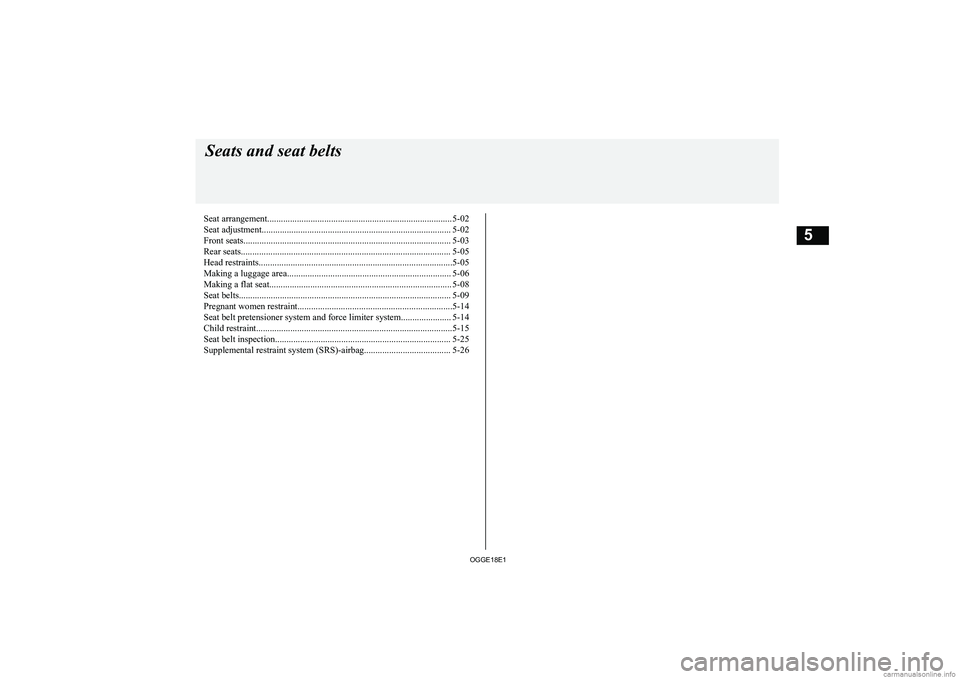
Seat arrangement................................................................................. 5-02
Seat adjustment................................................................................... 5-02 Front seats........................................................................................... 5-03
Rear seats............................................................................................ 5-05
Head restraints.....................................................................................5-05
Making a luggage area........................................................................ 5-06
Making a flat seat................................................................................ 5-08
Seat belts............................................................................................. 5-09 Pregnant women restraint....................................................................5-14
Seat belt pretensioner system and force limiter system...................... 5-14
Child restraint......................................................................................5-15 Seat belt inspection............................................................................. 5-25Supplemental restraint system (SRS)-airbag...................................... 5-26Seats and seat belts
OGGE18E15
Page 111 of 538
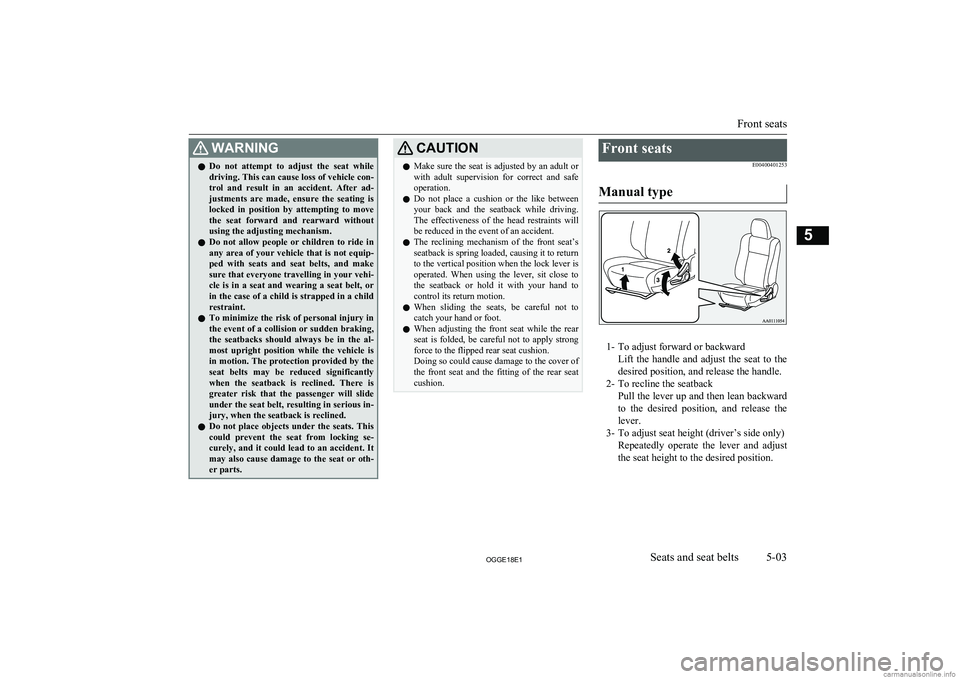
WARNINGlDo not attempt to adjust the seat while
driving. This can cause loss of vehicle con- trol and result in an accident. After ad-
justments are made, ensure the seating is locked in position by attempting to move
the seat forward and rearward without
using the adjusting mechanism.
l Do not allow people or children to ride in
any area of your vehicle that is not equip- ped with seats and seat belts, and make
sure that everyone travelling in your vehi- cle is in a seat and wearing a seat belt, or
in the case of a child is strapped in a child restraint.
l To minimize the risk of personal injury in
the event of a collision or sudden braking,the seatbacks should always be in the al-
most upright position while the vehicle is in motion. The protection provided by theseat belts may be reduced significantly
when the seatback is reclined. There is greater risk that the passenger will slide
under the seat belt, resulting in serious in- jury, when the seatback is reclined.
l Do not place objects under the seats. This
could prevent the seat from locking se-
curely, and it could lead to an accident. It may also cause damage to the seat or oth-
er parts.CAUTIONl Make sure the seat is adjusted by an adult or
with adult supervision for correct and safe operation.
l Do not place a cushion or the like between
your back and the seatback while driving.The effectiveness of the head restraints will
be reduced in the event of an accident.
l The reclining mechanism of the front seat’s
seatback is spring loaded, causing it to return
to the vertical position when the lock lever is
operated. When using the lever, sit close to the seatback or hold it with your hand to
control its return motion.
l When sliding the seats, be careful not to
catch your hand or foot.
l When adjusting the front seat while the rear
seat is folded, be careful not to apply strong force to the flipped rear seat cushion.
Doing so could cause damage to the cover of
the front seat and the fitting of the rear seat cushion.Front seats
E00400401253
Manual type
1- To adjust forward or backward Lift the handle and adjust the seat to the
desired position, and release the handle.
2- To recline the seatback Pull the lever up and then lean backwardto the desired position, and release the
lever.
3- To adjust seat height (driver’s side only)
Repeatedly operate the lever and adjustthe seat height to the desired position.
Front seats
5-03OGGE18E1Seats and seat belts5
Page 112 of 538
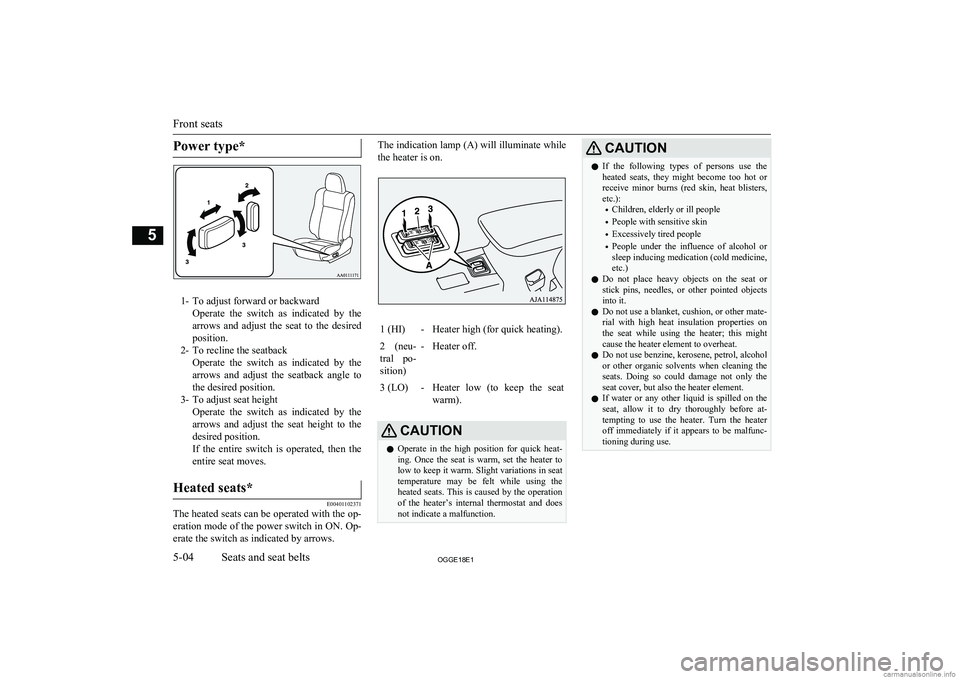
Power type*
1- To adjust forward or backwardOperate the switch as indicated by thearrows and adjust the seat to the desired
position.
2- To recline the seatback Operate the switch as indicated by thearrows and adjust the seatback angle to
the desired position.
3- To adjust seat height Operate the switch as indicated by thearrows and adjust the seat height to the
desired position.
If the entire switch is operated, then the entire seat moves.
Heated seats*
E00401102371
The heated seats can be operated with the op-
eration mode of the power switch in ON. Op-
erate the switch as indicated by arrows.
The indication lamp (A) will illuminate while
the heater is on.1 (HI)-Heater high (for quick heating).2 (neu-
tral po- sition)-Heater off.3 (LO)-Heater low (to keep the seat warm).CAUTIONl Operate in the high position for quick heat-
ing. Once the seat is warm, set the heater to low to keep it warm. Slight variations in seat
temperature may be felt while using the heated seats. This is caused by the operation
of the heater’s internal thermostat and does not indicate a malfunction.CAUTIONl If the following types of persons use the
heated seats, they might become too hot or receive minor burns (red skin, heat blisters,
etc.):
• Children, elderly or ill people
• People with sensitive skin
• Excessively tired people
• People under the influence of alcohol or
sleep inducing medication (cold medicine, etc.)
l Do not place heavy objects on the seat or
stick pins, needles, or other pointed objects into it.
l Do not use a blanket, cushion, or other mate-
rial with high heat insulation properties on the seat while using the heater; this might
cause the heater element to overheat.
l Do not use benzine, kerosene, petrol, alcohol
or other organic solvents when cleaning the seats. Doing so could damage not only the seat cover, but also the heater element.
l If water or any other liquid is spilled on the
seat, allow it to dry thoroughly before at-tempting to use the heater. Turn the heater
off immediately if it appears to be malfunc-
tioning during use.
Front seats
5-04OGGE18E1Seats and seat belts5
Page 116 of 538
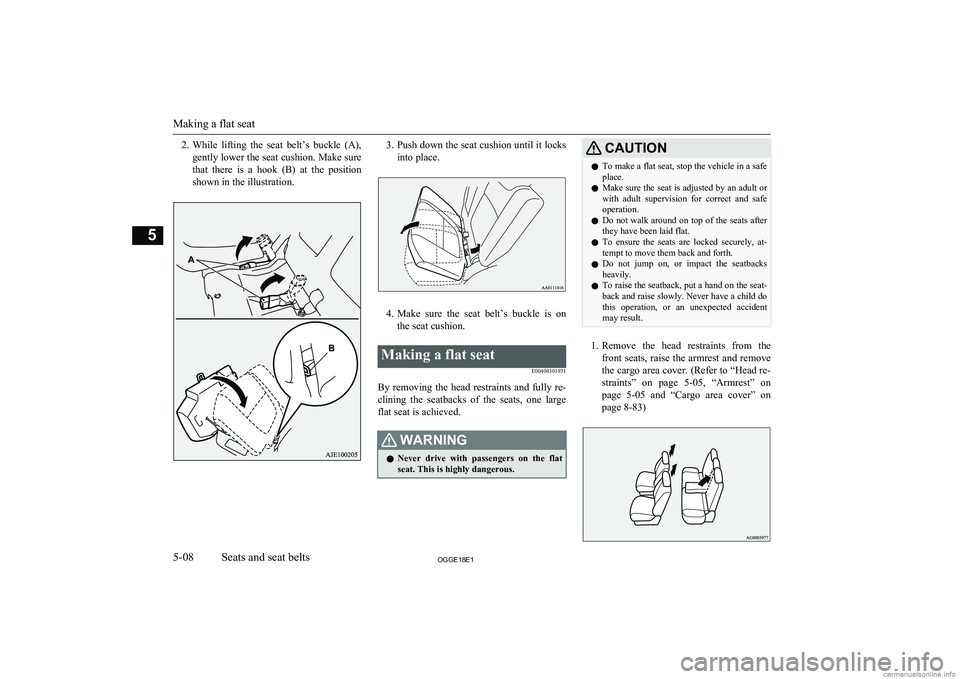
2.While lifting the seat belt’s buckle (A),
gently lower the seat cushion. Make sure that there is a hook (B) at the positionshown in the illustration.3. Push down the seat cushion until it locks
into place.
4. Make sure the seat belt’s buckle is on
the seat cushion.
Making a flat seat
E00404301931
By removing the head restraints and fully re-
clining the seatbacks of the seats, one large flat seat is achieved.
WARNINGl Never drive with passengers on the flat
seat. This is highly dangerous.CAUTIONl To make a flat seat, stop the vehicle in a safe
place.
l Make sure the seat is adjusted by an adult or
with adult supervision for correct and safe
operation.
l Do not walk around on top of the seats after
they have been laid flat.
l To ensure the seats are locked securely, at-
tempt to move them back and forth.
l Do not jump on, or impact the seatbacks
heavily.
l To raise the seatback, put a hand on the seat-
back and raise slowly. Never have a child do
this operation, or an unexpected accident
may result.
1. Remove the head restraints from the
front seats, raise the armrest and remove
the cargo area cover. (Refer to “Head re-
straints” on page 5-05, “Armrest” on
page 5-05 and “Cargo area cover” on
page 8-83)
Making a flat seat
5-08OGGE18E1Seats and seat belts5
Page 117 of 538
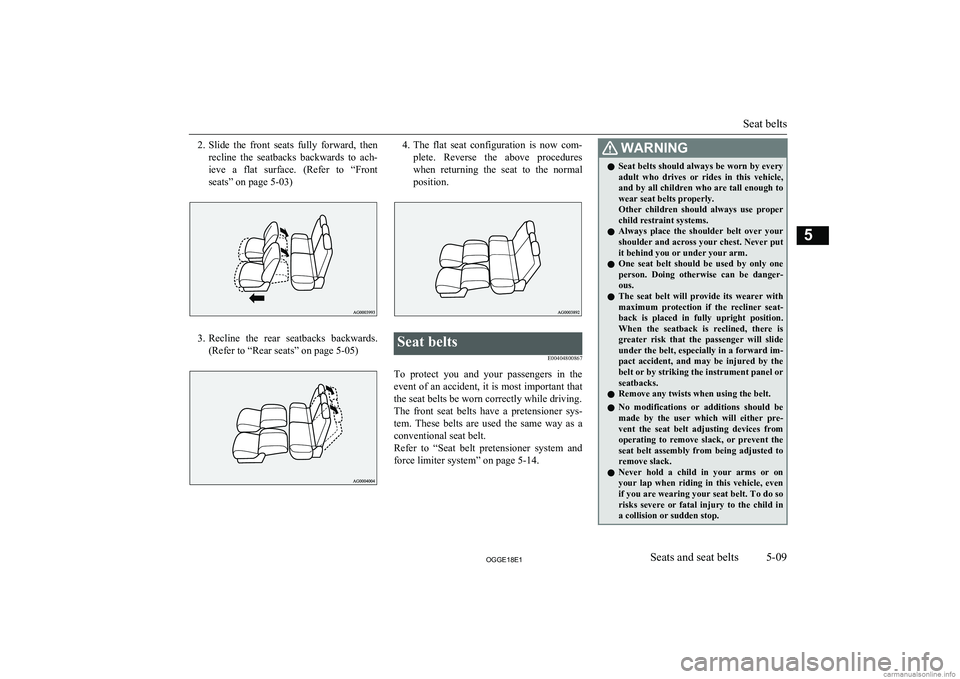
2.Slide the front seats fully forward, then
recline the seatbacks backwards to ach- ieve a flat surface. (Refer to “Front
seats” on page 5-03)
3. Recline the rear seatbacks backwards.
(Refer to “Rear seats” on page 5-05)
4. The flat seat configuration is now com-
plete. Reverse the above procedures
when returning the seat to the normal
position.Seat belts
E00404800867
To protect you and your passengers in theevent of an accident, it is most important thatthe seat belts be worn correctly while driving.
The front seat belts have a pretensioner sys- tem. These belts are used the same way as a
conventional seat belt.
Refer to “Seat belt pretensioner system and force limiter system” on page 5-14.
WARNINGl Seat belts should always be worn by every
adult who drives or rides in this vehicle,
and by all children who are tall enough to wear seat belts properly.
Other children should always use proper child restraint systems.
l Always place the shoulder belt over your
shoulder and across your chest. Never put
it behind you or under your arm.
l One seat belt should be used by only one
person. Doing otherwise can be danger-
ous.
l The seat belt will provide its wearer with
maximum protection if the recliner seat-
back is placed in fully upright position.
When the seatback is reclined, there is greater risk that the passenger will slide
under the belt, especially in a forward im-
pact accident, and may be injured by the
belt or by striking the instrument panel or seatbacks.
l Remove any twists when using the belt.
l No modifications or additions should be
made by the user which will either pre- vent the seat belt adjusting devices fromoperating to remove slack, or prevent the
seat belt assembly from being adjusted to
remove slack.
l Never hold a child in your arms or on
your lap when riding in this vehicle, even
if you are wearing your seat belt. To do so risks severe or fatal injury to the child in
a collision or sudden stop.
Seat belts
5-09OGGE18E1Seats and seat belts5